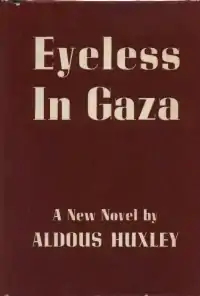Eyeless in Gaza (novel)
Eyeless in Gaza is a bestselling novel by Aldous Huxley, first published in 1936. The title originates from a phrase in John Milton's Samson Agonistes:
- ... Promise was that I
- Should Israel from Philistian yoke deliver;
- Ask for this great deliverer now, and find him
- Eyeless in Gaza at the Mill with slaves ...
 Dust-jacket from the first edition | |
| Author | Aldous Huxley |
|---|---|
| Country | United Kingdom |
| Language | English |
| Publisher | Chatto & Windus |
Publication date | 1936 |
| Media type | Print (Hardback) |
| Pages | 619 pp |
| ISBN | 978-0061724893 |
The title of the book, like Milton's poem, recalls the biblical story of Samson, who was captured by the Philistines, his eyes burned out, and taken to Gaza, where he was forced to work grinding grain in a mill.
The chapters of the book are not ordered chronologically. Huxley's biographer, Sybille Bedford, claims in her fictive memoir Jigsaw that the novel's characters Mary Amberley, a drug addict, and her daughter were partly inspired by her own experiences with her morphine-addicted mother and herself, known to Huxley because they were neighbours in the south of France.
Plot
The novel focuses on the life of socialite Anthony Beavis, but it does so by employing a non-chronological structure. It juxtaposes four periods of Beavis' life, from the time that he is a young boy in the 1890s up until 1936. The novel describes Beavis as he goes through school, college and various romantic affairs, while probing the meaningless lives of the upper-class during the same period. The novel depicts Beavis' own gradual disillusionment with high society, brought to a head by the suicide of his friend. At this point, he begins to search for some source of meaning in his life, which seems to be provided when he discovers pacifism and then mysticism.[1]
Critical reception
The English journalist Simon Heffer has called the novel Huxley’s best book and single ‘great novel’. For Heffer, the book both harkens back to Huxley’s early satires and links to the more serious and philosophical concerns of his later novels. Formally, he says that the novel uses a modernist, stream of consciousness approach, but bases these in fact, unlike Woolf, Proust and Joyce who use unreliable memories. The tension between war and pacifism is explored in the novel in a particularly productive way. Heffer concludes by writing that Huxley is a “sophisticated, original English man of letters” who deserves a reevaluation and that this novel is a good place to start.[2] Heffer also includes Eyeless in Gaza in Strictly English, his guide to clear English, as containing examples of Huxley’s mastery of parentheses (both brackets and dashes) and the single dash.[3] Blogger Josh Ronsen has created a table for those who want to read the novel in chronological order.[4]
Adaptation
It was adapted by Robin Chapman as a BBC mini-series in five episodes, screened in 1971.[5]
References
- Wasserman, Jerry (Winter 1980). "Huxley's Either/Or: The Case for "Eyeless in Gaza"". Novel: A Forum on Fiction. 13 (2): 188–203. doi:10.2307/1345309. JSTOR 1345309.
- Heffer, Simon, (20 October, 2018). Aldous Huxley did write a great novel - but it was not Brave New World. The Daily Telegraph.
- Heffer, Simon (2011). Strictly English: The Correct Way to Write... and Why It Matters. Random House. pp.33-34. ISBN 9780099537939
- Ronsen, Josh (August, 2010). LITERATURE: A Better Way to Read Aldous Huxley's Eyeless in Gaza. MonkMinkPinkPunk. Issue 17.
- "Eyeless in Gaza (TV Series 1971– )".
Further reading
- Bleiler, Everett (1948). The Checklist of Fantastic Literature. Chicago: Shasta Publishers. p. 156.
- Bedford, Sybille, Aldous Huxley: A biography - 1973 - the standard, two-volume authorised biography of Huxley